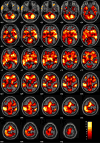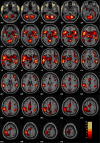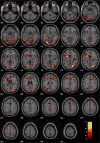The hemodynamics of oddball processing during single-tone and two-tone target detection tasks
- PMID: 16213043
- PMCID: PMC2766532
- DOI: 10.1016/j.ijpsycho.2005.07.012
The hemodynamics of oddball processing during single-tone and two-tone target detection tasks
Abstract
Event-related potential (ERP) studies have shown that the neural systems engaged during performance of oddball tasks are sensitive to contextual manipulations, such as the number of stimulus classes. Some ERP components (i.e., N1) are modulated by the number of stimulus types, while others (i.e., P3) are not greatly affected. However, little is known about how these contextual manipulations affect the hemodynamics underlying oddball processing. The purpose of this study was to examine the hemodynamic correlates of target stimulus processing in single-tone (targets alone) and two-tone (targets and standard tones) auditory oddball tasks. The primary hypothesis was that processing of salient stimuli in both contextual conditions would engage the same spatially distributed cortical and subcortical networks observed in previous oddball fMRI studies. Results were consistent with this hypothesis and suggest that the brain engages many potentially useful brain regions during salient stimulus processing despite the low probability that said regions are necessary for task performance, which likely reflects a form of "adaptive reflexive processing". Results were also consistent with ERP data that shows that the N1 is larger for single-tone tasks by showing greater amplitude of hemodynamic response for single-tone targets, relative to two-tone targets, in bilateral temporal cortex and bilateral inferior lateral frontal cortex. The results are discussed as they relate to the understanding of neurocognitive function pertaining to contextual manipulations in general, and orienting processes in particular.
Figures




Similar articles
-
Attentional modulation in the detection of irrelevant deviance: a simultaneous ERP/fMRI study.J Cogn Neurosci. 2006 May;18(5):689-700. doi: 10.1162/jocn.2006.18.5.689. J Cogn Neurosci. 2006. PMID: 16768370 Free PMC article.
-
An adaptive reflexive processing model of neurocognitive function: supporting evidence from a large scale (n = 100) fMRI study of an auditory oddball task.Neuroimage. 2005 Apr 15;25(3):899-915. doi: 10.1016/j.neuroimage.2004.12.035. Neuroimage. 2005. PMID: 15808990
-
The spatio-temporal dynamics of deviance and target detection in the passive and active auditory oddball paradigm: a sLORETA study.BMC Neurosci. 2018 Apr 19;19(1):25. doi: 10.1186/s12868-018-0422-3. BMC Neurosci. 2018. PMID: 29673322 Free PMC article.
-
Abnormal hemodynamics in schizophrenia during an auditory oddball task.Biol Psychiatry. 2005 May 1;57(9):1029-40. doi: 10.1016/j.biopsych.2005.01.035. Biol Psychiatry. 2005. PMID: 15860344 Free PMC article.
-
Stimulus-dependent activations and attention-related modulations in the auditory cortex: a meta-analysis of fMRI studies.Hear Res. 2014 Jan;307:29-41. doi: 10.1016/j.heares.2013.08.001. Epub 2013 Aug 11. Hear Res. 2014. PMID: 23938208 Review.
Cited by
-
Fixating targets in visual search: The role of dorsal and ventral attention networks in the processing of relevance and rarity.Imaging Neurosci (Camb). 2024 Jul 17;2:imag-2-00229. doi: 10.1162/imag_a_00229. eCollection 2024. Imaging Neurosci (Camb). 2024. PMID: 40800370 Free PMC article.
-
Psychopathic traits associated with abnormal hemodynamic activity in salience and default mode networks during auditory oddball task.Cogn Affect Behav Neurosci. 2018 Jun;18(3):564-580. doi: 10.3758/s13415-018-0588-2. Cogn Affect Behav Neurosci. 2018. PMID: 29633199 Free PMC article.
-
Neurofeedback Training of Auditory Selective Attention Enhances Speech-In-Noise Perception.Front Hum Neurosci. 2021 Jun 22;15:676992. doi: 10.3389/fnhum.2021.676992. eCollection 2021. Front Hum Neurosci. 2021. PMID: 34239430 Free PMC article.
-
Involvement of the dorsal and ventral attention networks in oddball stimulus processing: a meta-analysis.Hum Brain Mapp. 2014 May;35(5):2265-84. doi: 10.1002/hbm.22326. Epub 2013 Jul 30. Hum Brain Mapp. 2014. PMID: 23900833 Free PMC article.
-
Abnormal frontoparietal synaptic gain mediating the P300 in patients with psychotic disorder and their unaffected relatives.Hum Brain Mapp. 2017 Jun;38(6):3262-3276. doi: 10.1002/hbm.23588. Epub 2017 Mar 27. Hum Brain Mapp. 2017. PMID: 28345275 Free PMC article.
References
-
- Anderer P, Pascual-Marqui RD, Semlitsch HV, Saletu B. Differential effects of normal aging on sources of standard N1, target N1 and target P300 auditory event-related brain potentials revealed by low resolution electromagnetic tomography (LORETA) Electroencephalogr Clin Neurophysiol. 1998;108:160–174. - PubMed
-
- Baudena P, Halgren E, Heit G, Clarke JM. Intracerebral potentials to rare target and distractor auditory and visual stimuli. III. Frontal cortex. Electroencephalogr Clin Neurophysiol. 1995;94:251–264. - PubMed
-
- Braver TS, Barch DM, Gray JR, Molfese DL, Snyder A. Anterior cingulate cortex and response conflict: Effects of frequency, inhibition and errors. Cereb Cortex. 2001;11:825–836. - PubMed
-
- Budd TW, Barry RJ, Gordon E, Rennie C, Michie PT. Decrement of the N1 auditory event-related potential with stimulus repetition: habituation vs. refractoriness. Int J Psychophysiol. 1998;31:51–68. - PubMed
-
- Calhoun VD, Stevens MC, Pearlson GD, Kiehl KA. fMRI analysis with the general linear model: removal of latency-induced amplitude bias by incorporation of hemodynamic derivative terms. Neuroimage. 2004;22:252–257. - PubMed
Publication types
MeSH terms
Substances
Grants and funding
LinkOut - more resources
Full Text Sources

